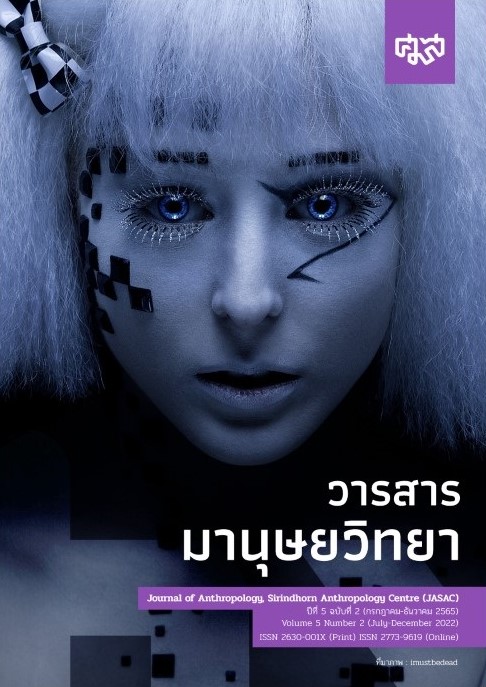เส้นแบ่งและรอยต่อของพื้นที่และเวลาระหว่างผีและคนไทดำในกะล้อห่อง
Main Article Content
บทคัดย่อ
บทความนี้มีเป้าหมายในการนำเสนอสิ่งที่ค้นพบจากการศึกษาภาคสนามขั้นต้น (preliminary fieldwork) ต่อการใช้พื้นที่ร่วมกันในบ้านเดียวกันระหว่างคนที่ยังมีชีวิตอยู่และผีบรรพบุรุษที่สิงสถิตอยู่ในกะล้อห่อง ทั้งในช่วงเวลาปกติในชีวิตประจำวันและในช่วงเวลาของพิธีกรรมอันศักดิ์สิทธิ์อย่างพิธีเสนเรือนและป๊าดตง โดยศึกษาภาคสนามขั้นต้นใน 10 เรือนของชาวไทดำในหมู่บ้านคุยยาง ตำบลบางระกำ อำเภอบางระกำ จังหวัดพิษณุโลก เพื่อค้นหาคำตอบให้กับคำถามในสามประเด็น หนึ่ง เส้นแบ่งเขตแดนระหว่างพื้นที่ของคนและพื้นที่ของผีเป็นเช่นไรเมื่อศึกษาผ่านพื้นที่กะล้อห่อง สอง ปรากฏโครงสร้างอะไรบ้างเบื้องหลังการใช้พื้นที่ร่วมกันในบ้านเดียวกันระหว่างคนกับผี สาม ความสัมพันธ์ทางสังคมและทางสัญลักษณ์ของการใช้พื้นที่ร่วมกัน ระหว่างคนและผีเป็นเช่นไร ทั้งนี้ ผู้เขียนใช้กรอบแนวคิดจากการปริทัศน์งานของ Eliade (1961), Smith (1987) และ Segaud, M. (2012) ซึ่งนอกจากบทความชิ้นนี้จะอธิบายว่าพื้นที่ธรรมดาพื้นที่หนึ่งกลายมาเป็นพื้นที่ศักดิ์สิทธิ์อย่างกะล้อห่องได้อย่างไรแล้ว บทความชิ้นนี้ยังนำเสนอข้อค้นพบเบื้องต้นและคำ อธิบายต่อเรื่องโครงสร้างและความสัมพันธ์ทางสังคมและเวลาที่อยู่เบื้องหลังกะล้อห่องอีกด้วย
Article Details

อนุญาตภายใต้เงื่อนไข Creative Commons Attribution-NonCommercial-NoDerivatives 4.0 International License.
ลิขสิทธิ์@ของวารสารมานุษยวิทยา
ศูนย์มานุษยวิทยาสิรินธร (องค์การมหาชน), กรุงเทพฯ, ประเทศไทย
ข้อมูลเพิ่มเติม:
https://creativecommons.org/licenses/by-nc-nd/4.0/
เอกสารอ้างอิง
กานต์ทิตา สีหมากสุก. (2558). วิเคราะห์ปัจจัยการดํารงอยู่และการเปลี่ยนแปลงความเชื่อในพิธีกรรมของไทยทรงดํา: กรณีศึกษาเขตตําบลหนองปรง อําเภอเขาย้อย จังหวัดเพชรบุรี. ปรัชญาดุษฎีบัณฑิต สาขาวิชาไทยศึกษา มหาวิทยาลัยบูรพา.
กาญจนา สุวรรณศิลป์ และคณะ. (2546). ความดํารงอยู่ของอัตลักษณ์ชาวไทยทรงดํา (ลาวโซ่ง): กรณีศึกษาบ้านสระพัฒนา อําเภอกําแพงแสนจังหวัดเชียงใหม่. การศึกษาค้นคว้าด้วยตนเอง ศิลปศาสตรมหาบัณฑิต สาขาวิชาสังคมศึกษา มหาวิทยาลัยนเรศวร.
เชาวน์มนัส ประภักดี. (2558). ผีในโลกทัศน์ของคนไทดําและมอญในชุมชนท้องถิ่นภาคกลาง: บทสังเคราะห์โครงการยุววิจัยประวัติศาสตร์ท้องถิ่นพื้นที่ภาคกลาง. ใน รายงานสืบเนื่องการประชุมวิชาการระดับชาติสถาบันวิจัยและพัฒนา มหาวิทยาลัยราชภัฏกําแพงเพชร ครั้งที่ 2 (หน้า 144-164). กําแพงเพชร: มหาวิทยาลัยราชภัฏกําแพงเพชร.
ฐาปนีย์ เครือระยา. (2560). การสร้างถิ่นฐาน บ้าน และเรือนคนไทดําไทขาวในเวียดนาม. วารสารข่วงผญา, 12: 122-156.
ติ๊ก แสนบุญ. เอกลักษณ์ในที่พักของชาวไทดํา “เฮือนไทดํา” เมืองแถง (เดียนเบียนฟู) เวียดนาม. เข้าถึงเมื่อ 3 ตุลาคม 2565. สืบค้นจาก https://www.silpa-mag. com/culture/article_600#https://www.silpa-mag.com/ culture/article_6000#:~:text.
ธัญณ์ณภัทร์ เจริญพานิช. (2559). ผีและอํานาจ ผ่านความเชื่อเรื่องผีของชาวไทยทรงดําตําบลพันเสา อําเภอบางระกํา จังหวัดพิษณุโลก. วารสารราชพฤกษ์, 14(2): 67-74.
พิเชฐ สายพันธ์. (2562). พลวัตจักรวาลทัศน์และโลกทัศน์สํานึกประวัติศาสตร์ ชาติพันธุ์กับถิ่นฐานต้นกําเนิดของลาวโซ่ง/ ไทดําจากพิธีกรรมความตาย. วารสารมานุษยวิทยา, 2(2): 49-80.
พระมหาอานนท์ เหลือบแล. (2552). กว๊านขับ: การวิเคราะห์วิถีชีวิตไทยทรงดํา ในเขตอําเภอวังทอง จังหวัดพิษณุโลก. การศึกษาค้นคว้าด้วยตนเอง ศิลปศาสตรมหาบัณฑิต สาขาวิชาภาษาไทย มหาวิทยาลัยนเรศวร.
ภูมิชาย พันธุ์ไพโรจน์. (2554). ไทดํารําพันถึงเรือนกระดองเต่า: จากขุนเขาเมืองแถงสู่ลุ่มน้ำภาคกลางของไทย. วารสารวิจัยและสาระสถาปัตยกรรม/การผังเมือง, 8(1): 21-34.
ยุกติ มุกดาวิจิตร. (2557). ประวัติศาสตร์ไทดํา: รากเหง้าวัฒนธรรม-สังคมไทยและเอเชียตะวันออกเฉียงใต้. กรุงเทพ: สํานักศิลปวัฒนธรรมร่วมสมัย กระทรวงวัฒนธรรม.
เรณู เหมือนจันทร์เชย. (2558). หน้าที่ทางสังคมของความเชื่อผีบรรพบุรุษไทยโซ่ง บ้านเกาะแรต จังหวัดนครปฐม. วารสารภาษาและวัฒนธรรม, 34(1): 85-103.
เรณู เหมือนจันทร์เชย. (2561). การจัดการความรู้ในพิธีเสนเรือนของไทยทรงดํา. วารสารมหาวิทยาลัยศิลปากร, 38(1): 1-24.
สมคิด ศรีสิงห์. (2521). รายงานการวิจัยเรื่อง วัฒนธรรมไทยโซ่งดํา (ลาวโซ่ง) ในจังหวัดพิษณุโลกและพิจิตร. พิษณุโลก: มหาวิทยาลัยนเรศวร.
อภิญวัฒน์ โพธิ์สาน. (2553). สารัตถะ คติความเชื่อ และพิธีกรรมลาวโซ่ง. วารสารมนุษยศาสตร์และสังคมศาสตร์ มหาวิทยาลัยมหาสารคาม, 29(2): 136-154.
อัญชลี สิงห์น้อย วงศ์วัฒนา. (2559). อัตลักษณ์ ภูมิปัญญา และการสืบสาน ภาษาชาติพันธุ์ไทดําภาคเหนือตอนล่าง. พิษณุโลก: มหาวิทยาลัยนเรศวร.
Chaturawong, C. (2017). Ancestral Beliefs and Spatial Organization of Tai Dam Houses. Proceedingin 13th International Conference on Thai Studies “Globalized Thailand? Connectivity, Conflict and Conundrums of Thai Studies”, 15-18 July 2017, Chiang Mai, Thailand.
Chiranthanut, C. & Funo, S. (2008). Considerations on Spatial Formation and Transformation of Kaloeng House in Mukdahan province, Thailand. Journal of Architecture Planning, 73(633): 2285-2292.
Eliade, M. (1961). The Sacred and the Profane: The Nature of Religion. New York: Harper & Brothers.
Hauser-Schäublin, B. (2004). The Politics of Sacred Space: Using Conceptual Models of Space for Socio-Political Transformation in Bali. Bijdragen tot de Taal-, Land-en Volkenkunde, 160(2/3): 283-314.
Rao, U. (2018). Sacred Space. In H. Callan (Ed.). The International Encyclopedia of Anthropology (pp. 1-7). New Jersey: John Wiley & Sons.
Smith, J. Z. (1987). To take place: Toward Theory in Ritual. Chicago: University of Chicago Press.
Segaud, M. (2012). Anthropologie de l’espace: Habiter, Fonder, Distribuer, Transformer. Paris: Armand Colin.
Turton, A. (1978). Architectural and Political Space in Thailand. In G.B. Milner (Ed.). Natural Symbols in South East Asia. (pp.111-128). London: School of Oriental and African Studies.
Weinberg, J. (2013). Surfing the Shifting Boundary between Sacred and Profane: Confluence, Dwelling, and Crossing. Journal for the Study of Religion, 26(1): 45-60.


